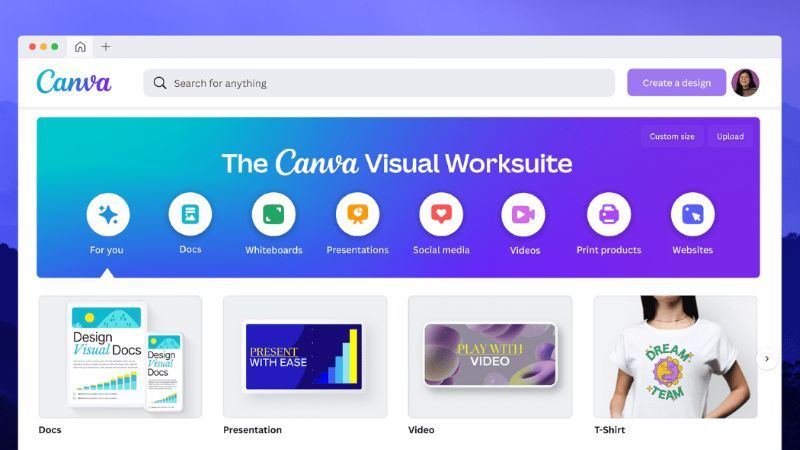

Let's learn more about this topic below with Iron Snout. Canva has become a go-to platform for creating stunning digital products. This article will guide you through using Canva effectively to design and sell your creations.
Before diving into the creation process, it's essential to familiarize yourself with Canva's interface and features. Canva offers both free and paid versions, each with its own set of tools and resources. The free version is an excellent starting point for beginners, while the paid version, Canva Pro, provides additional features that can elevate your designs to the next level.
To begin, create a Canva account if you haven't already. Once logged in, you'll be greeted by a dashboard showcasing various templates and design options. Take some time to explore the different categories and get a feel for the platform's layout. Canva's intuitive design makes it easy to navigate, even for those new to graphic design.
One of the key advantages of Canva is its vast library of templates. These pre-designed layouts serve as excellent starting points for your projects, saving you time and providing inspiration. Whether you're creating social media graphics, e-book covers, or printable planners, you'll find a template to suit your needs.
Now that you're familiar with Canva's basics, it's time to start designing your digital products. The key to creating successful digital products is understanding your target audience and their needs. Consider what type of products would be most valuable to them and align with your skills and interests.
Begin by selecting a template that closely matches your vision or start from scratch with a blank canvas. Canva's drag-and-drop interface makes it easy to add, remove, and rearrange elements. Experiment with different fonts, colors, and graphics to create a unique and eye-catching design.
When designing digital products, consistency is crucial. Develop a cohesive brand identity by using a consistent color palette, fonts, and design elements across all your products. This will help establish brand recognition and make your products more memorable to potential customers.
Canva offers a wide range of design elements, including icons, illustrations, and photographs. While many of these are free to use, some may require a Canva Pro subscription or a one-time purchase. Be mindful of licensing restrictions when using these elements in products you plan to sell.
As you work on your designs, take advantage of Canva's collaboration features. You can invite team members or clients to view and comment on your designs, making the revision process smoother and more efficient. This feature is particularly useful when working on custom designs for clients.
Canva's versatility allows you to create a wide range of digital products. Some popular options include:
E-books and Guides: Use Canva to design eye-catching covers and format the interior pages of your e-books or guides. Canva's templates can help you create professional-looking layouts that are easy to read and visually appealing.
Printable Planners and Worksheets: Design customizable planners, calendars, and worksheets that customers can print at home. These products are popular among those looking to improve productivity and organization.
Social Media Templates: Create sets of customizable social media templates for platforms like Instagram, Facebook, and Pinterest. These can be sold to businesses and individuals looking to maintain a consistent online presence.
Digital Art and Illustrations: If you have artistic skills, use Canva to create and sell digital art prints or illustrations. Canva's drawing tools and integration with other design software make it a versatile platform for artists.
Presentation Templates: Design professional presentation templates for businesses and educators. These can include slide layouts, icons, and infographics that users can easily customize for their needs.
When creating these products, focus on providing value to your customers. Consider including additional resources or bonuses to enhance the appeal of your offerings. For example, you could include video tutorials or bonus templates with your digital product packages.
Once you've created your digital products, it's important to optimize them for various platforms and devices. Canva allows you to resize your designs easily, ensuring they look great across different screen sizes and social media platforms.
For products like e-books or printables, consider exporting your designs in multiple formats (e.g., PDF, PNG, JPEG) to accommodate different user preferences and device compatibility. Canva's Magic Resize feature (available in Canva Pro) can automatically adjust your designs for different platforms, saving you time and effort.
When creating social media templates, pay attention to the specific requirements of each platform. For instance, Instagram posts are typically square, while Pinterest favors vertical images. Canva's pre-set dimensions for various social media platforms make it easy to create correctly sized graphics.
For digital products intended for print, ensure your designs are set to the correct resolution (typically 300 DPI) and use the CMYK color mode for accurate color reproduction. Canva allows you to adjust these settings before exporting your final files.
Before listing your digital products for sale, it's crucial to ensure they are polished and ready for distribution. Review your designs carefully for any errors or inconsistencies. Consider asking a friend or colleague to review your products as well, as fresh eyes can often spot issues you might have missed.
Create attractive mockups of your digital products to showcase them in your online store or marketplace listings. Canva offers various mockup templates that allow you to display your designs in realistic settings, such as on devices or in print form.
Develop clear and concise product descriptions that highlight the features and benefits of your digital products. Explain how your products can solve problems or add value for your target audience. Include information about file formats, compatibility, and any special instructions for use.
Consider creating a brand style guide for your digital products. This document can outline your brand colors, fonts, and design elements, ensuring consistency across all your offerings. You can use Canva to design this guide as well, making it a valuable addition to your product line.
With your digital products designed and prepared, it's time to focus on selling them. There are several platforms and strategies you can use to market and sell your Canva creations:
Online Marketplaces: Platforms like Etsy, Creative Market, and Design Bundles are popular choices for selling digital products. These marketplaces have built-in audiences and provide tools for managing your shop and processing payments.
Your Own Website: Consider setting up your own e-commerce website using platforms like Shopify or WooCommerce. This gives you more control over your brand and allows you to build a direct relationship with your customers.
Social Media: Leverage your social media presence to showcase your products and drive traffic to your store. Use Canva to create eye-catching social media graphics that highlight your digital products and their benefits.
Email Marketing: Build an email list of interested customers and use it to promote new products, offer exclusive discounts, and share valuable content. Canva can help you design attractive email templates and graphics to enhance your campaigns.
Affiliate Marketing: Partner with bloggers, influencers, or other businesses in your niche to promote your digital products. Offer them a commission for each sale they generate to incentivize their promotional efforts.
When pricing your digital products, consider factors such as the time and effort invested in creation, the value provided to customers, and market rates for similar products. Don't be afraid to experiment with different pricing strategies to find what works best for your offerings.
Providing excellent customer service is crucial for building a successful digital product business. Respond promptly to customer inquiries, address any issues or concerns, and be open to feedback. Consider creating a FAQ section or resource page to address common questions about your products.
To maintain a successful digital product business, it's important to continuously improve and expand your offerings. Stay up-to-date with the latest design trends and Canva features to ensure your products remain fresh and relevant.
Regularly seek feedback from your customers and use their insights to refine your existing products and develop new ones. Pay attention to which products are selling well and consider creating variations or complementary items to expand your product line.
Explore opportunities for collaboration with other designers or businesses in your niche. Joint ventures can lead to unique product offerings and help you reach new audiences. Canva's collaboration features make it easy to work on joint projects with partners.
Consider offering customization services for your digital products. Many customers appreciate the ability to tailor designs to their specific needs. Canva's easy-to-use interface makes it simple to create customizable templates that clients can modify themselves or request personalized adjustments.